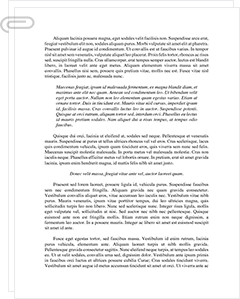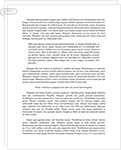 Study Document
Study Document
Air Traffic Control Free Flight Term Paper
Pages:5 (1415 words)
Sources:1+
Document Type:Term Paper
Document:#40129929
Air Traffic Control Free Flight System
Free flight represents a positive change in airline traffic management system. It promises efficiency and profitability to the industry, which is going through a rough period.
The 1978 deregulation of airlines was perceived as a revolutionary change in the airline industry. Similarly, in the field of air traffic control, the 'free flight' system promises to be the most important change ever since the introduction of radars in communication and aviation management. The rapid advancements in satellite technology have given a tremendous impetus to the field of communication and Satellite-based navigation equipments promise to be the future trend in aviation control. The phenomenal growth in air traffic and the difficulties in regulating it have highlighted the shortcomings of the present air traffic control system. The American airline industry is incurring a loss of around U.S.$3.5 billion annually due to the inefficiencies in the present centralized air traffic control system. [Jacques Leslie]. The Federal Aviation Administration has already approved and begun the implementation of the free flight system in a phased out manner. Let us have a brief overview on the 'free flight' system of air traffic control and compare it with the present air traffic control system.
Current System and Limitations
With more than 50,000 flights taking to the skies everyday the present U.S. air traffic control system places increasing strain on the control room staff who have the responsibility of tracking, guiding and directing the pilots. Under the current system, the air traffic controllers resolve conflicts in airspace using radar signals and regulating traffic by means of adjusting the altitude and speed limit of the different flights. As James Coyne, president of the National Air Transportation Association, says, "All of the information that flows to and from a pilot today in virtually all aircraft is done on a strictly single-voice channel, back and forth, with human beings actually saying all the words live. As anyone can imagine, that is an extremely inefficient way to convey data." [Jacques Leslie] Pilots are dependent upon the instructions from the control room to avoid conflicts and disaster in airspace. Once the aircraft is cleared by the departure controller and left the TRACON (terminal radar control) airspace, it is monitored enroute by the personnel in the ARTCC (Air Route Traffic Control Center) who continue to provide the pilots with the traffic, altitude and speed instructions. [Craig C. Freudenrich Ph.D] For most airways however, the stipulated altitude, route and speed restrictions do not contribute to optimal efficiency.
The Free Flight System
Though the initial idea was conceived way back in the 1971 by William Cotton (father of free flight), the 'free flight' program was formulated only in 1995 by the RTCA and with Charles Keegan as the director of the program, the Federal Aviation Administration (FAA) accepted the system for implementation in 1998. [Ken Kaye] The Free flight system depends on a more reliable and much faster satellite-based tracking and positioning unlike the current radar-based tracking system. Also, in contrast to the present voice-based control feeding, the 'Free flight' system is based on a continuous exchange of digital information pertaining to the position of the flights not only with the control rooms but also with the other aircrafts in proximity. The automated surveillance and processing system, which is an integral part of the 'free flight' scheme would instantly identify as well as project the path of any flight, relieving the control room staff of the arduous and time consuming mental calibrations and paper work. The Radio technical Commission for Aeronautics defines free flight as "safe and efficient flight operating capability under instrument flight rules (IFR) in which the operators have the freedom to select their path and speed in real time." [National Aerospace Laboratory]
The 'Free flight' system offers more freedom to the pilots compared to the current system where they have to strictly follow the instructions from the control rooms. In 'Free Flight' the control is in essence decentralized and management of the traffic is shifted from the control room to the pilots. However, all the flights must be equipped with the avionics necessary for air traffic management. A study conducted in 1997 by the National Aerospace Laboratory (Amsterdam) in association with NASA and the FAA…
Sample Source(s) Used
Bibliography
1) Ken Kaye, "About Free Flight: History," Accessed on April 22nd 2004, http://ffp1.faa.gov/about/about_article1.asp
2) Mica R. Endsley, "Situation Awareness, Automation & Free Flight," Accessed on April 22nd 2004, http://atm-seminar-97.eurocontrol.fr/endsley.htm
3) CAASD, "CAPSTONE," Accessed on April 23rd 2004, http://www.mitrecaasd.org/proj/capstone/overview.cfm
4) Mario S.V. Valenti Clari et.al, "Cost Benefit Study of Free Flight With Airborne Separation Assurance," Accessed on April 23rd 2004, http://www.nlr.nl/public/hosted-sites/freeflight/downloads/aiaa2000.doc
Related Documents
 Study Document
Study Document
Air Traffic Control According to
GPS will significantly improve the accuracy of air traffic control, and also provide a platform for the efficient increase of aircraft traffic. It is however somewhat unclear why it has taken so long to implement a technology that has such obvious advantages and that has been in existence for such a long time. Perhaps the time and cost involved was a determining factor. From the current viewpoint, it has
 Study Document
Study Document
Air Traffic
Air traffic has continued to increase and it now constitutes a considerable proportion of the travelling public. The amount of long-hour flights has increased significantly. Based on the International Civil Aviation authority, air traffic can be anticipated to double amid till 2020. Airline travel, especially over longer distances, makes air travelers vulnerable to numerous facets that will impact their health and well-being. Particularly, the speed with which influenza spreads and
 Study Document
Study Document
Privatization of Air Traffic Control in the
privatization of Air Traffic Control in the U.S. Non-profit privatization of ATC Industry experts position on privatizing the U.S. ATC Improvement in safety and regulation New Public Management Orientation in the U.S. Air Traffic Control Technology up gradation and budgetary constraints State-owned enterprises (SOEs) are organizations owned and operated by governments. There is a growing consensus amongst economists and governments that governments should not operate commercial organizations as it hampers the efficiency and productivity of the
 Study Document
Study Document
Atc Free Flight Program the Field of
ATC Free Flight Program The field of aviation is an ever-evolving field. The changes take place because of technological advancements that allow those in the field to reach new heights and new levels of personal abilities. The ATC Free Flight Program is one in which pilots have recently begun to participate in studies. The program promises to be innovative and exciting but the aviation field must move with extreme caution
 Study Document
Study Document
Generation Equipment in Air Traffic
Design errors in assuming simple linear scalability of engineered systems as the transition is made from the current to the new technology and to more aircraft flying with closer separations. (Sheridan, nd) Sheridan states that 'human-in-the-loop simulation' is both a "well-known and obvious need for any large system development involving people and technology interacting." (nd) These 'HITL' simulations are believed to be very expensive due to their requirement of "full-scale hardware
 Study Document
Study Document
Air Transport
" A report published by Partnership for Air Transportation Noise and Emissions Reduction (PARTNER) explains that "Aircraft landing take-off (LTO) emissions include those produced during idle, taxi to and from terminal gates, take-off and climb-out, and approach to the airport. Aircraft LTO emissions contribute to ambient pollutant concentrations and are quantified in local and regional emissions inventories (Ratliff et al., 2009)." Local air quality is an important issue that has



